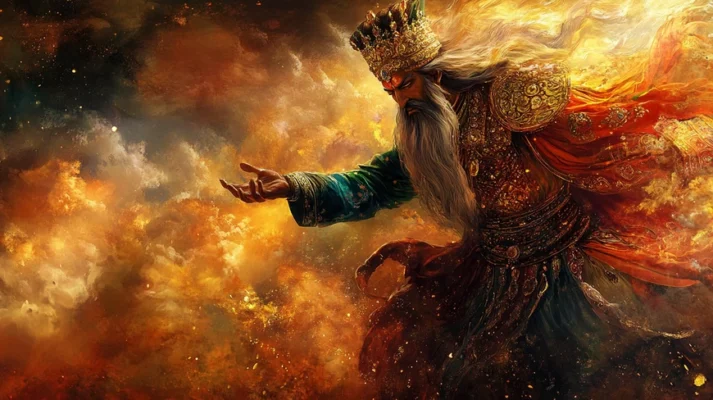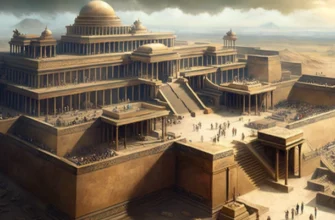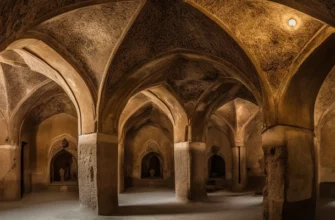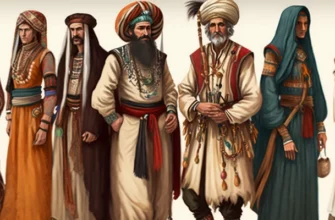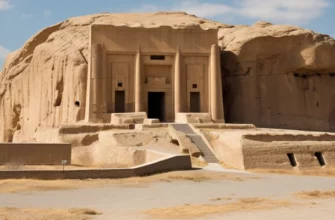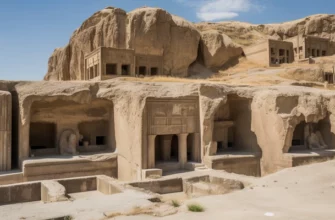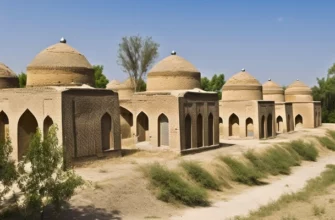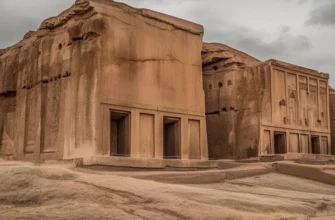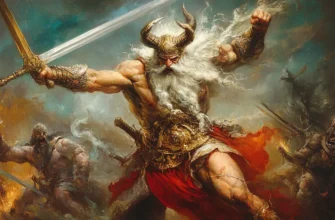Yima is one of the central figures in Iranian mythology and Zoroastrianism, known as the king, creator, and protector of humanity. He embodies ideal order, prosperity, and life. In ancient texts such as the Avesta, Yima is known for his task of creating a safe place for humanity during a global catastrophe — Varsha Yima, a kind of paradise where saved living beings can survive the disaster.
Yima mythology tells of a golden age when people lived without disease or death under his rule. He received gifts from the god Ahura Mazda for the benefit of humanity: the ability to increase the earth, create animals and plants. However, his main mission was to build a protective shelter for the chosen ones when the ice age was approaching.
In Zoroastrianism, Yima symbolizes prosperity and well-being, but he also has traits of downfall, as he refused to become a prophet and ultimately suffered degradation. His story has a significant influence on Iranian culture, woven into folklore and literature.
The origin of Yima
Yima is a key figure in ancient Iranian mythology and Zoroastrianism, embodying ideal order and prosperity. His image originates from ancient Indo-Iranian beliefs, where he was considered a divine king and the first man to receive divine knowledge and the ability to rule the world from Ahura Mazda. In Zoroastrianism, Yima is not a god in the full sense, but rather an ideal ruler chosen to protect and guide humanity.
According to the texts of the Avesta, Yima received a command from Ahura Mazda to create an ideal world where there would be no evil, disease, or suffering. This mission gave him the status of a divine ruler and creator of a prosperous society. Yima symbolizes the golden age of humanity, when the world was populated by happy people, animals, and plants living in harmony.
However, over time, Yima refused to become a prophet and take responsibility for the spiritual guidance of humanity, which undermined his position. He ceased to be the ideal king and eventually lost the favor of Ahura Mazda.
Major religious traditions featuring Yima
Yima appears mainly in the Iranian religious tradition of Zoroastrianism, but his image also has echoes in more ancient Indo-Iranian myths.
Zoroastrianism
In Zoroastrianism, Yima is one of the central characters, especially in the texts of the Avesta. He is depicted as the first king, whom Ahura Mazda entrusted with ruling the world and helping humanity survive the first great trials, such as the cold catastrophe. His role is associated with the creation of a refuge for chosen beings, where they were able to survive during times of calamity. However, in Zoroastrianism, Yima, despite his status and greatness, falls because of his refusal to become a prophet.
Indian Vedas (Indo-Iranian mythology)
Yima has certain parallels in the Indian Vedic tradition, where he may correspond to the figure of Yama, the first human and ruler of the underworld. In Indo-Aryan beliefs, Yama is also considered a divine king and leader of humanity after death, which echoes the theme of divine leadership in Yima. Although these two figures developed in different religious contexts, their origins can be traced back to common Indo-Iranian roots.
Mythology of pre-Zoroastrian Iran
Before the emergence of Zoroastrianism, Yima was part of older Iranian myths. His figure was associated with a golden age and ideal rule, where the world knew neither death nor disease. This pre-Zoroastrian mythology was filled with ideas about Yima as a symbol of the ideal ruler who created prosperity on earth.
Yima as a character and symbol exists at the intersection of mythology, religion, and philosophy. His image combines ancient ideas about the ideal king, divine leader, and protector of humanity in various religious contexts.
Yima’s connection to the Iranian gods
Yima, as a central figure in Iranian mythology, has a close connection with the Iranian gods, especially with the supreme deity of Zoroastrianism, Ahura Mazda. His role as the first king and protector of humanity is the result of direct interaction with these deities.
Ahura Mazda
Ahura Mazda, the chief deity of Zoroastrianism, acts as the creator of the world and Yima’s mentor. It is he who gives Yima power over the world, entrusting him with ruling and protecting humanity from disasters. Ahura Mazda gives Yima the task of creating Varsha, a refuge for the preservation of living beings during the coming cataclysm. Despite this, Yima eventually refuses to fulfill his spiritual leadership of humanity and becomes a more secular king, losing the favor of Ahura Mazda.
Mithra
Mithra, the god of light, truth, and treaties, plays an important role in Iranian religion. Although Yima has no direct connection to Mithra in known myths, they are both symbols of order and justice. Yima, as king, was called upon to uphold truth and harmony, which echoes the principles for which Mithra is responsible. Presumably, his reign perfectly matched the divine order established by Mithra.
Angra Mainyu (Ahriman)
Angra Mainyu, the personification of evil and chaos in Zoroastrianism, acts as the opposite of Ahura Mazda. His presence is not direct in the story of Yima, but it is likely that he was a threat to the world that the ruler was trying to protect. When disaster looms over the world, it is precisely because of the forces of chaos that Yima is forced to create Varsha to protect the chosen beings.
Sraosha (Srausha)
Sraosha, the god of obedience and submission to the will of Ahura Mazda, plays an important role in Zoroastrianism, protecting order and law enforcement. Perhaps the image of Sraosha influences the myth of Yima, when he receives instructions from Ahura Mazda and follows them. After Yima’s fall, it is Sraosha who may symbolize the spiritual order that the king was unable to uphold.
Thus, Yima is closely connected to the main deities of Iranian mythology, as his mission to rule the world and protect humanity is part of the divine plan established by Ahura Mazda. His story also reminds us of the importance of maintaining a balance between good and evil, as well as obedience to the divine will.
His place among other gods
Yima occupies a unique place in Iranian mythology and Zoroastrianism. Although he is not a god in the strict sense, his status as the first king and ruler chosen by Ahura Mazda makes him one of the central figures in the pantheon of deities.
An intermediary figure between gods and humans
Yima acts as a kind of mediator between gods and humans. Unlike deities such as Ahura Mazda or Mithra, Yima is not a divine creator or an omnipotent protector of the world order.
However, he received from Ahura Mazda the gift of rule and responsibility for the protection of humanity, which elevates him above mere mortals. His mission to create an ideal world and a refuge for the chosen people during the cataclysm also indicates that he was chosen to carry out important divine plans.
King and cultural hero
In Zoroastrianism, Yima plays the role not only of a ruler but also of a cultural hero who contributes to the development of humanity and prosperity. His reign marked a “golden age” when the world was free from evil, death, and disease. Yima not only protects people, but also contributes to their evolution — increasing the land, multiplying animals and plants, which makes him similar to the semi-divine cultural heroes of other mythologies, such as Prometheus in Greek mythology.
Difference from Ahura Mazda and Mithra
Unlike Ahura Mazda, who is the creator and supreme deity, Yima does not have absolute power. His reign has its limits, and although he receives his power from Ahura Mazda, his refusal to become a prophet and take on the spiritual leadership of humanity leads to his downfall. Unlike Mithra, who is associated with light and truth, Yima is a more earthly figure who focuses on the physical protection and prosperity of humanity.
A fallen figure
Yima has an important characteristic that distinguishes him from other deities: he experiences a fall. Despite his exalted position, Yima loses the favor of Ahura Mazda by refusing to become a prophet.
This makes him a more human character compared to the flawless deities. His degradation is reminiscent of the tragedies of great kings or heroes from other cultures, such as Gilgamesh or Odysseus, who also face the limits of their power.
Thus, Yima occupies an intermediate place between gods and humans: he is not a god, but his status exceeds that of ordinary mortals. He is an ideal king, a cultural hero, and a protector of humanity, but his refusal to perform spiritual duties leads to his downfall, making him a complex and multifaceted figure in Iranian mythology.
How Yima created the ideal world
According to Iranian mythology and Zoroastrianism, Yima created the ideal world under the guidance of the supreme god Ahura Mazda. His main mission was to ensure the prosperity of humanity and protect it during a global catastrophe. His actions were instrumental in creating a harmonious, safe place to live, which became known as Yima’s “golden age.”
Expanding the land for the population
Ahura Mazda instructed Yima to create conditions for the prosperity of humanity. One of Yima’s key tasks was to expand the land so that it could accommodate more people, animals, and plants. The Avesta texts say that Yima, with the help of magical powers received from Ahura Mazda, expanded the land several times so that it could accommodate all creatures.
Creating a prosperous society
Yima’s reign was marked by a world free from evil, disease, and death. People and all living creatures lived in peace, prosperity, and harmony. During this period, humanity did not face suffering, and the earth’s fertility was high. Yima ensured balance in nature, creating conditions for the stable growth and development of all creatures.
Protecting humanity from cataclysms
An important aspect of the myth of Yima was his task to build the Vahsh Yima — a shelter for selected people, animals, and plants that would allow them to survive a global disaster, namely the onset of the ice age (in another version of the myth — the universal flood). On the instructions of Ahura Mazda, Yima created this shelter underground, where the climate remained warm and suitable for life. This space functioned as a paradise on Earth, where all the chosen ones could live in safety.
Maintaining harmony and order
Yima was responsible for maintaining perfect order in the world, adhering to the divine laws established by Ahura Mazda. He was a just and wise ruler who ensured prosperity and stability in society. His reign symbolized order and harmony, which were the main principles of the Zoroastrian worldview.
Thus, Yima created an ideal world by expanding the earth, ensuring prosperity, and protecting against future disasters. Although his role as an ideal ruler was successful in maintaining harmony, his refusal to take on spiritual leadership ultimately led to his downfall, but his reign became a symbol of a golden age.
Cultural influence of the image of Yima
The image of Yima in Iranian mythology and Zoroastrianism has a significant cultural influence that can be traced through history, literature, art, and contemporary culture. His figure symbolizes ideals, values, and lessons that have left a deep mark on people’s consciousness. Here are some aspects of this influence:
Literature and folklore
The image of Yima has become an important element of Iranian literature and folklore. He is often mentioned in epics, myths, and folk tales, where his role as the first king and cultural hero emphasizes the ideals of justice, wisdom, and development. Works depicting his exploits contribute to the preservation and dissemination of Zoroastrian values in society.
Art
In art, Yima is depicted as a symbol of the ideal ruler and cultural hero. He often becomes the central figure in painting, sculpture, and decorative art. His image embodies aesthetic and moral aspects that are important to Iranian culture, as well as reflecting the concept of fighting evil and achieving prosperity.
Religious influence
As an important figure in Zoroastrianism, Yima shapes religious traditions and rituals. His symbolism is associated with the concept of light, truth, and moral responsibility. In Zoroastrian rituals, Yima is honored as the protector of humanity, inspiring believers to adhere to moral principles in their lives.
Parallels in other cultures
The image of Yima as a cultural hero finds parallels in other mythologies, such as the image of Prometheus in Greek mythology, demonstrating the universality of his symbolism. These similarities promote cross-cultural exchange and mutual enrichment, making Yima’s image influential not only in the Iranian context but also internationally.
Contemporary culture
In contemporary culture, Yima continues to be an important symbol, particularly in literature, cinema, and art. His image is often used to embody themes of the struggle for justice, the protection of humanity, and the pursuit of ideals. Contemporary artists and writers refer to his story to emphasize the relevance of his concepts in the modern world.
Environmental and social movements
The image of Yima as a protector of life and nature can be used in the context of contemporary environmental and social movements. His symbolism of protecting and promoting the prosperity of nature inspires people to take action and make efforts to improve the ecological state of the planet. This makes Yima a relevant symbol in the struggle for sustainable development and environmental awareness.
Impact on identity
The image of Yima also plays a role in shaping the identity of the Iranian people, emphasizing their cultural and religious heritage. His figure inspires national pride and emphasizes the importance of traditions that shape society.
Thus, the cultural influence of the image of Yima extends across various aspects of life, from literature and art to religious practices and contemporary social movements. Its symbolism continues to be relevant, inspiring people to fight for justice, prosperity, and harmony in the world.
Conclusion
The image of Yima occupies a unique and important place in Iranian mythology and Zoroastrianism, symbolizing the ideals of justice, wisdom, and prosperity. As the first king and cultural hero, he embodies values that are fundamental to Iran’s religious and cultural tradition.
His role in creating an ideal world and protecting humanity from evil reflects the central concepts of Zoroastrianism, where the struggle between good and evil is the main narrative. Yima serves as a mediator between gods and humans, demonstrating the responsibility and moral choices that each individual must make in life.
His fall due to his refusal to fulfill his spiritual duties reminds us of the importance of responsibility and the consequences of our actions, making his image not only noble but also human.
Yima’s cultural influence can be traced in literature, art, and contemporary culture, where his figure continues to inspire people to seek harmony, justice, and development. He has become a symbol of environmental awareness, which is relevant in the context of today’s challenges related to nature conservation.
In conclusion, Yima is a multifaceted and complex figure who unites religious and cultural values. His influence continues to shape the identity of the Iranian people and inspires new generations to strive for well-being and prosperity. His story serves as a powerful reminder of the importance of morality, responsibility, and harmony in all aspects of life.
